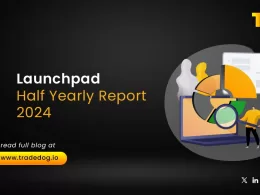Quick Links
I. Introduction
The world of cryptocurrency trading can be both exciting and daunting. With the rapid growth of digital currencies like Bitcoin, traders are constantly seeking innovative tools and techniques to improve their trading strategies. One such tool that has gained significant popularity is the Bitcoin Rainbow Chart. In this blog, we will explore the various use cases and benefits of using Bitcoin Rainbow Charts in cryptocurrency trading.
II. Understanding the Rainbow Chart
The Rainbow Chart is a visualization tool that represents data using different color bands. It is drawn by assigning a unique radius to each bar, which represents the data being displayed. The chart is designed to be visually appealing and eye-catching, making it an effective way to present information.
A. Description of the x-axis and y-axis
In the Rainbow Chart, the x-axis represents the time dimension, and it is displayed horizontally. This axis shows the progression of time, allowing viewers to observe trends and patterns over a specific period. The y-axis, on the other hand, represents the measurement scale. It is displayed vertically and represents the values or data being measured. The numerical values on the y-axis depict the magnitude or quantity of the data being visualized.
B. Definition of different color bands on the chart
The Rainbow Chart uses different color bands to represent the data being visualized. Each color band corresponds to a specific range or category of data. The distinct colors help differentiate between different segments or groups of data, making it easier to identify patterns or compare values.
C. Role of moving averages in creating the chart
Moving averages play a significant role in creating the Rainbow Chart. The concept of moving averages involves calculating the average value of a subset of data points over a specific period. By incorporating moving averages into the chart, the visual representation becomes smoother and less volatile, allowing for a clearer understanding of underlying trends and patterns.
III. Interpreting the BTC Rainbow Chart
A. Identifying Support and Resistance Levels
Support and resistance levels are crucial in determining potential reversal points in a market trend. Support refers to a price level where buying pressure is strong enough to prevent a decline in the price, while resistance is a level where selling pressure hinders upward movement. The BTC Rainbow Chart can help identify these levels effectively. Here’s how:
- Familiarize yourself with the BTC Rainbow Chart: Understanding its structure, color bands, and their significance. Each band represents a different percentage range of price movement, reflecting market sentiment and trend changes.
- Observe price movements: Look for areas on the chart where the price struggles to move beyond (resistance) or bounces back from (support) repeatedly. These levels indicate the presence of strong buying or selling pressure and are significant in determining support and resistance.
- Analyze chart patterns: Identify any patterns that suggest support or resistance levels. For example, connecting multiple lows with a horizontal line indicates support, while connecting multiple highs indicates resistance. Trendlines, channels, and other technical analysis tools can also help in identifying these levels.
- Consider volume and market sentiment: Take into account the trading volume at specific price levels and the overall market sentiment. Higher volumes near certain levels confirm the significance of support or resistance. Understanding market sentiment helps gauge the strength of these levels.
- Use additional indicators: Utilize other technical indicators like moving averages, oscillators, or Fibonacci retracement levels to further confirm the identified support and resistance levels.
- Make informed decisions: After analyzing chart patterns, price movements, volume, market sentiment, and additional indicators, make decisions on the identified support and resistance levels. Ensure these levels align with the overall objective of interpreting the BTC Rainbow chart.
Remember to rely on objective analysis rather than personal biases or emotions when making these decisions. Thoroughly analyze the chart, use multiple tools and indicators, and consider the reasoning behind each identified level.
B. Using the Chart to Gauge Market Sentiment
Market sentiment refers to the overall attitude or feeling of traders and investors towards a particular asset. The BTC Rainbow Chart can be used to gauge market sentiment effectively. Here’s how:
- Analyze band positions: Examine the positioning of the bands relative to each other on the chart. This can provide insights into market sentiment.
- Observe chart shape and patterns: Analyze the overall shape of the chart and any emerging patterns. These can indicate bullish (positive) or bearish (negative) sentiment.
- Consider color dominance: Note the dominance of specific colors on the chart. If the chart is mostly green, it suggests a bullish sentiment, while a mostly red chart suggests a bearish sentiment.
By utilizing the BTC Rainbow Chart to gauge market sentiment, you can make more informed decisions about entering or exiting trades.
IV. Benefits and Limitations of the BTC Rainbow Chart
Advantages of using the chart for BTC analysis:
- Visual representation: The chart provides a clear and visually appealing way to analyze BTC price trends and identify potential buying or selling opportunities. It uses a color-coded spectrum to represent different price levels, making it easier to interpret.
- Historical reference: The chart incorporates historical data to provide context and help traders understand where BTC’s price currently stands in relation to its past performance. This can be valuable in making informed decisions and predicting future price movements.
- Support and resistance levels: The chart helps identify key support and resistance levels, which are important in technical analysis. Traders can use these levels to determine potential entry and exit points, as well as set stop-loss orders.
- Trend identification: By analyzing the chart, traders can identify trends in BTC’s price movement. This can be helpful in determining whether the market is bullish or bearish and adjusting trading strategies accordingly.
Potential drawbacks and challenges in interpretation:
- Subjectivity: As with any technical analysis tool, the interpretation of the BTC Rainbow Chart is subjective. Different traders may have different interpretations of the chart, leading to potential inconsistencies in decision-making.
- Lagging indicator: The BTC Rainbow Chart relies on historical data, which means it may not always accurately reflect the current market conditions. It is important to consider other factors and indicators in conjunction with the chart for a more comprehensive analysis.
- Limited predictive power: While the chart can provide insights into past price movements, it is not a foolproof predictor of future price trends. Market conditions can change rapidly, and other external factors can influence BTC’s price, making it challenging to solely rely on the chart for decision-making.
VII. Conclusion
In conclusion, the BTC Rainbow chart is a powerful tool that can enhance the decision-making process for traders and investors in the cryptocurrency market. Its ability to simplify complex data, identify support and resistance levels, and detect trend reversals make it a valuable asset. However, it should always be used in conjunction with other analysis methods to ensure comprehensive decision-making.









